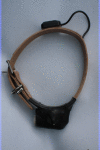Global positioning system derived performance measures are responsive indicators of physical activity, disease and the success of clinical treatments in domestic dogs
- PMID: 25692761
- PMCID: PMC4332864
- DOI: 10.1371/journal.pone.0117094
Global positioning system derived performance measures are responsive indicators of physical activity, disease and the success of clinical treatments in domestic dogs
Abstract
Objective: To assess the use of Global Positioning System receiver (GPS) derived performance measures for differentiating between: 1) different outdoor activities in healthy dogs; 2) healthy dogs and those with osteoarthritis; 3) osteoarthritic dogs before and after treatment with non-steroidal anti-inflammatory analgesia.
Design: Prospective study.
Animals: Ten healthy dogs and seven dogs with osteoarthritis of the elbow joint (OA dogs).
Procedure: Healthy dogs were walked on a standard route on-lead, off-lead and subjected to playing activity (chasing a ball) whilst wearing a GPS collar. Each dog was walked for five consecutive days. Dogs with OA were subjected to a single off-lead walk whilst wearing a GPS collar, and then administered oral Carprofen analgesia daily for two weeks. OA dogs were then subjected to the same walk, again wearing a GPS collar.
Results: GPS derived measures of physical performance could differentiate between on-lead activity, off-lead activity and playing activity in healthy dogs, and between healthy dogs and OA dogs. Variation in the performance measures analysed was greater between individual dogs than for individual dogs on different days. Performance measures could differentiate healthy dogs from OA dogs. OA Dogs treated with Carprofen analgesia showed improvements in their physical performance, which returned to values indistinguishable from those of healthy dogs on nearly all the measures assessed.
Conclusions and clinical relevance: GPS derived measures of physical performance in dogs are objective, easy to quantify, and can be used to gauge the effects of disease and success of clinical treatments. Specific stimuli can be used to modulate physical performance beyond the self-governed boundaries that dogs will naturally express when allowed to exercise freely without stimulation.
Conflict of interest statement
Figures





Similar articles
-
Carprofen simultaneously reduces progression of morphological changes in cartilage and subchondral bone in experimental dog osteoarthritis.J Rheumatol. 2000 Dec;27(12):2893-902. J Rheumatol. 2000. PMID: 11128682
-
Power of treatment success definitions when the Canine Brief Pain Inventory is used to evaluate carprofen treatment for the control of pain and inflammation in dogs with osteoarthritis.Am J Vet Res. 2013 Dec;74(12):1467-73. doi: 10.2460/ajvr.74.12.1467. Am J Vet Res. 2013. PMID: 24274882 Clinical Trial.
-
Comparative efficacy and safety of mavacoxib and carprofen in the treatment of canine osteoarthritis.Vet Rec. 2015 Mar 14;176(11):284. doi: 10.1136/vr.102397. Epub 2014 Nov 27. Vet Rec. 2015. PMID: 25433056 Free PMC article. Clinical Trial.
-
Use of carprofen for the treatment of pain and inflammation in dogs.J Am Vet Med Assoc. 1997 May 15;210(10):1493-8. J Am Vet Med Assoc. 1997. PMID: 9154204 Review.
-
Pharmacokinetics, pharmacodynamics, toxicology and therapeutics of mavacoxib in the dog: a review.J Vet Pharmacol Ther. 2015 Feb;38(1):1-14. doi: 10.1111/jvp.12185. Epub 2014 Nov 21. J Vet Pharmacol Ther. 2015. PMID: 25413929 Review.
Cited by
-
Effects of Topical Anaesthetic and Buccal Meloxicam Treatments on Concurrent Castration and Dehorning of Beef Calves.Animals (Basel). 2018 Feb 28;8(3):35. doi: 10.3390/ani8030035. Animals (Basel). 2018. PMID: 29495653 Free PMC article.
-
Anti-nerve growth factor therapy increases spontaneous day/night activity in mice with orthopedic surgery-induced pain.Pain. 2017 Apr;158(4):605-617. doi: 10.1097/j.pain.0000000000000799. Pain. 2017. PMID: 28301858 Free PMC article.
-
External validation of a collar-mounted triaxial accelerometer for second-by-second monitoring of eight behavioural states in dogs.PLoS One. 2017 Nov 29;12(11):e0188481. doi: 10.1371/journal.pone.0188481. eCollection 2017. PLoS One. 2017. PMID: 29186154 Free PMC article.
References
-
- Hansen BD, Lascelles BD, Keene BW, Adams AK, Thomson AE (2007) Evaluation of an accelerometer for at-home monitoring of spontaneous activity in dogs. Am J Vet Res 68: 468–475. - PubMed
-
- Buchanan JW (1999) Prevalence of Cardiovascular Disorders. In: Fox PR, Sisson D, Moise NS, editors. Textbook of Canine and Feline Cardiology. Philadelphia: Saunders, W.B; pp. 457–470.
-
- Clarke SP, Mellor D, Clements DN, Gemmill T, Farrell M et al. (2005) Prevalence of radiographic signs of degenerative joint disease in a hospital population of cats. Vet Rec 157: 793 - PubMed
Publication types
MeSH terms
Substances
Grants and funding
LinkOut - more resources
Full Text Sources
Other Literature Sources
Medical

